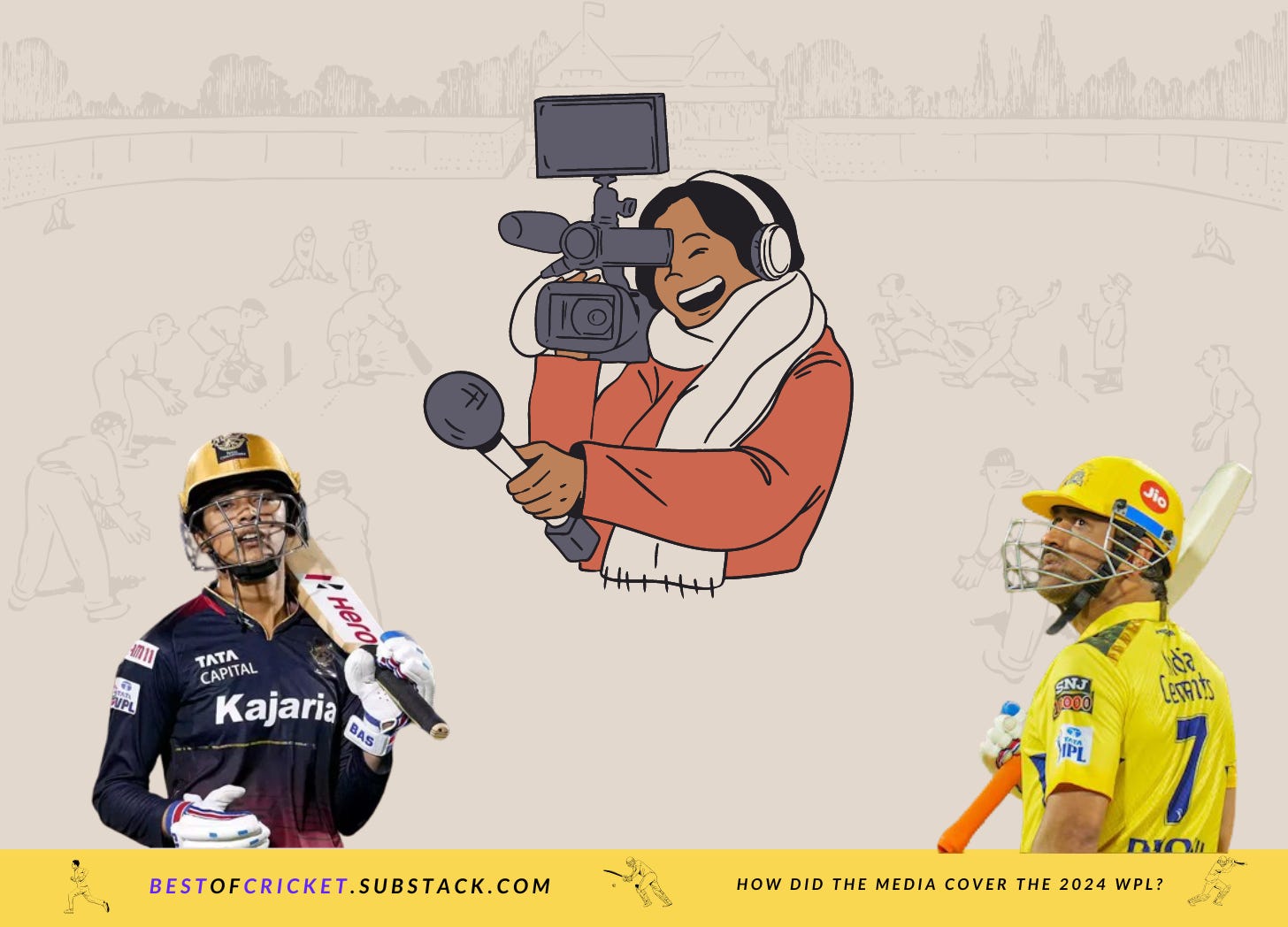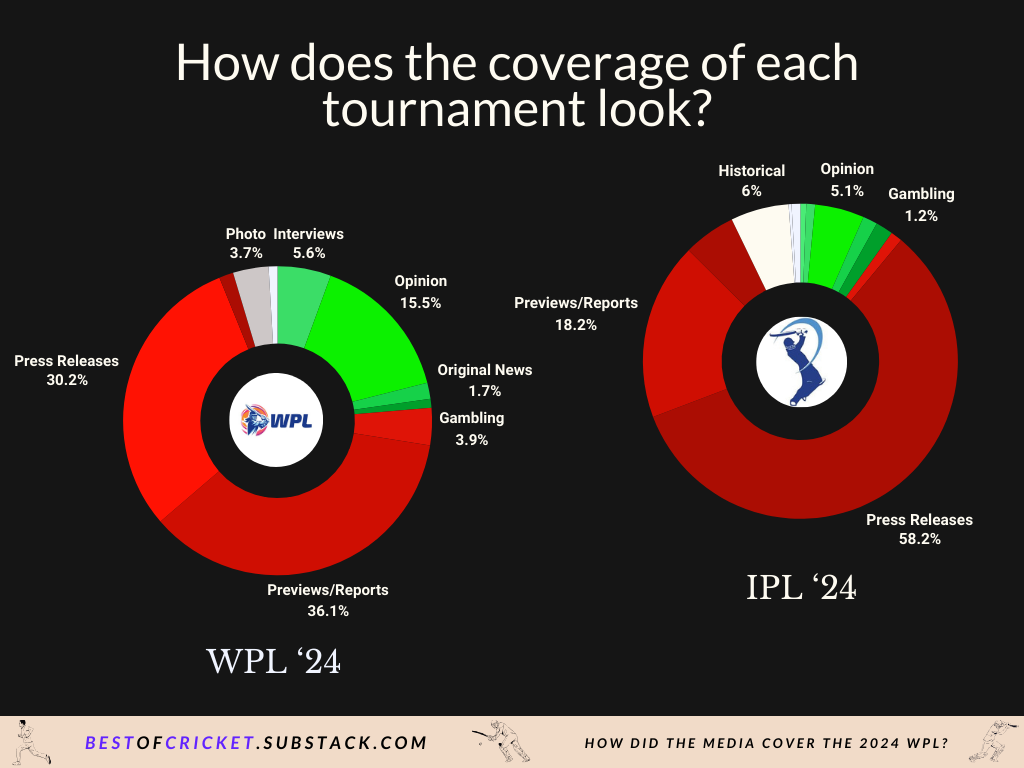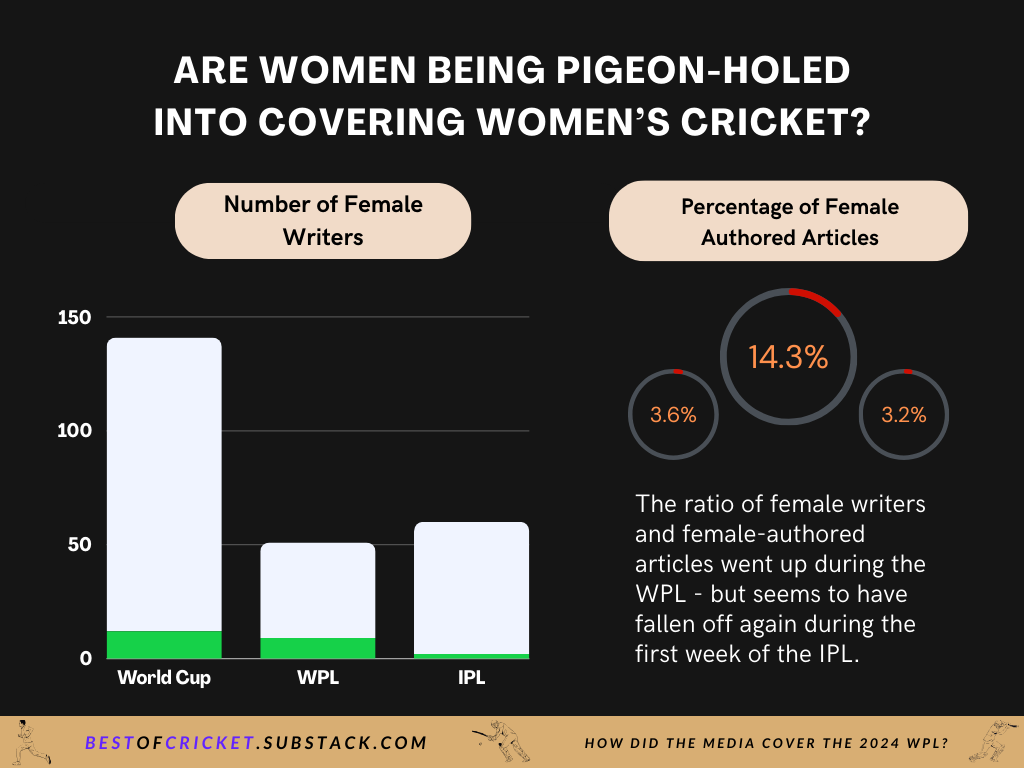REPORT: How did the Indian media cover the WPL?
I looked at the good, the bad and the ugly of WPL coverage, to figure out what we can expect during the IPL.
For those of you that are new here, this newsletter compiles the best cricket stories from the last 24 hours. That means, every morning, I’ve got to go through tons of clickbait to find a few gems.
But, something funny happened during the Women’s Premier League. There was far more coverage than I was expecting, and a lot of it was…nuanced? They weren't just reproductions of a player’s latest Instagram post, or endless articles about. Every. Single. Minor. Development.
So, it got me thinking; does the media cover the Women’s game differently?
There are obvious reasons for doing so. The Women’s Premier League has a smaller audience than the Indian Premier League. Last year’s WPL final saw 10M concurrent viewers, a number the IPL hit on just streaming devices way back in 2018.
Additionally, the audiences are not as familiar with the women compared to their male counterparts. RCB’s No.18s - Virat Kohli & Smriti Mandhana - are the most followed Men’s and Women’s cricketers on Instagram. Mandhana has a truly incredible 11M+ followers, but Kohli absolutely dwarfs that number with 267M followers.
Finally, the WPL audiences haven’t had the time to develop an interest and in-depth understanding of the teams and league. The ESPNcricinfo ball-by-ball commentary for this year’s WPL final saw 7 user-submitted comments, while the 2023 IPL final saw 168 user-submitted comments.
It made me wonder how you can possibly cover the WPL & the IPL the same way. They’re almost different sports with different audience sizes, interests and in-depth knowledge.
And, yet, despite the huge audience disadvantages, coverage of the Women’s game feels…better?
There’s really only one way to figure out what’s going on. So, I did it again. I went through 537 articles from five outlets on the WPL, and another 335 articles from the same outlets on the IPL (so far) to find a simple answer; how do media outlets cover Women’s cricket versus Men’s cricket?1
You can find the data set I used here.
Jump to a section:
How are the WPL & IPL covered differently?
Which teams get the most coverage, and why?
Which outlet has the best coverage?
My prediction for the 2024 IPL
How are the WPL & IPL covered differently?
To determine how the leagues are covered, I tagged each article with some qualitative descriptions. Good tags include interviews, opinion pieces, statistical analyses & original news reporting. Bad tags include gambling, press releases (and articles that are basically re-written press releases), run-of-the-mill match previews & reports, and social media posts repackaged as “stories”.
To boil it down, good stories are ones that took some effort and expertise to write, and are unique because of that. Bad stories are those that are easily replicated across the Internet (almost word-for-word), articles that could’ve just been Tweets, & stories that promote gambling.2
The first learning is obvious; cricket coverage is terrible. As I’m sure most of you suspected, there’s a LOT of cricket clickbait on the Internet.
But, it’s clear that my hunch was right. Media outlets seem to have better coverage of the WPL compared to the IPL.
In fact, when compared to how the same outlets covered the ODI World Cup last year, you can see an interesting trend. The five outlets published 537 WPL articles to 2,211 World Cup articles, and yet they published 30 interviews during the WPL and only 26 interviews during the World Cup!
However, these outlets also published 63 statistical analyses during the World Cup, but only 5 statistical analyses during the WPL.3 Why is that?

I talked to Somesh Agarwal, Head of Content at Cricket.com, to understand how they cover women’s cricket versus men’s cricket.
During the WPL, Cricket.com is focussed on using big performances and eye-catching moments to better introduce players to the audience. As Agarwal said, “There was a conscious effort to focus more on player-centric pieces to shed light on up and coming players who are yet to become household names.”
However, when covering men’s cricket, the emphasis is different. On Cricket.com’s strategy for the IPL, Agarwal emphasised that they would be providing all kinds of different stories for audiences. “It involves covering different aspects of every game: live blogs, analysis articles, stats pieces, match stories, watchalongs and social media posts,” he said. “Our written content is largely tailored towards telling a story through numbers.”
The numbers back this up. Interviews that introduce players and their unique stories to the public were far more likely during the WPL, while opinion pieces & statistical analyses were far more likely during the Men’s games. In a sport with fewer highly informed audience members, it makes more sense to introduce players than to publish niche deep dives.
However, there is another reason why the WPL - and particular teams in the WPL - see more “good” stories.
Which teams get the most coverage, and why?
In the IPL, the ratio is pretty clear. The more popular a team is, the more coverage it gets. I don’t think any reporters are covering teams based on their Instagram following but, after 16 years, it's easy to understand that editorial strategies may have naturally drifted towards covering the teams with the biggest audiences (similar to why India gets more coverage at the national level than Ireland).
However, in the WPL, matters are more complicated. Some of the Women’s teams share handles with their Men’s teams, so Bangalore (13.3M), Mumbai (12.9M) & Delhi (4M) just have astronomically higher follower counts than Gujarat (266K) or UP (78.5K) who don’t share their ownership with a Men’s team.
Similarly, RCB had higher coverage because they played the most matches, and won the whole tournament. There was more cause to cover them.
In a league that doesn’t draw eyeballs without marketing expense, engaging media coverage is far more important to the WPL teams. Thus, a more important metric may be how many “good” stories each team gets.
According to anecdotal evidence from reporters I’ve talked to, the WPL teams are generally more welcoming of reporters than IPL teams because they need the media coverage more. But some teams are more welcoming than others.
The Gujarat Giants & the UP Warriorz are new teams that want as much media exposure as they can get. They account for 20 of the 29 interviews & 11 of the 16 opinion pieces published during the WPL. When you are more willing to talk to the press, it’s easier for them to write about you.
Unfortunately for both teams, they’ve been pretty bad on the pitch, so they haven’t gotten the media boosts of the champions (RCB) or the eternal playoff contenders (MI & DC). If they can be more competitive next year, they might just be able to skew their exposure rates to much higher levels. UPW have already done a great job by just being relatively competitive during the league stage.
Which outlet has the best coverage?
We’re going to go back to the “good” and “bad” story metrics to figure this one out.

If you read my last piece on how these outlets covered the World Cup, these numbers should look familiar. The standard is incredibly low, ESPNcricinfo are relatively decent, News18 are hilariously clickbait-y, & Sportstar are surprisingly bad but with fantastic “good” stories.
But, the real surprises here are Cricket.com & Cricbuzz. The latter seemed to just not care about the tournament too much, while the former were absolutely fantastic. Even their match reports were very good, with a unique focus on a new player in every piece to try and introduce the Women’s stars to a new audience.
Talking to Cricket.com’s Somesh Agarwal, it sounds like this strategy produced real results for them. Apparently, the WPL period saw similar audience numbers as the World Cup, and 3X their numbers from the 2023 WPL!
In particular, I wanted to single out Gaurav Nandan Tripathi for praise. He has been covering the Women’s game since at least the December internationals between England, Australia & India and his expertise really showed through. He managed to put out 30 articles during a tournament that only saw 22 matches!
Two of the other great writers during this tournament were Cricbuzz’s Purnima Malhotra (17 stories) & Sportstar’s Lavanya Lakshmi Narayan (29 stories). Given a rare chance to shine, both carried their respective publications’ coverage of the WPL.
Which brings us pretty neatly to my next point. The participation of female journalists rose pretty dramatically from the World Cup’s abysmal rates.
However, that number seems to have dropped pretty drastically again with the IPL. One explanation could be that the WPL just finished and the IPL just started, so the female journalists are just taking a breather before getting back on the cycle.
But, if you take into consideration how long each journalist has been at their respective outlet, and how few articles they seem to author at both the World Cup & the IPL combined, it does start to feel like the WPL was an outlier.

There are caveats to this graph, as there always will be. Valkyrie Baynes & Firdose Moonda are both based outside India, so the fact they do any WPL or IPL coverage is surprising. Additionally, this is a basic analysis of how many stories they have published - everyone has other responsibilities that may take precedence over writing.
But, these are still the most prolific female writers across all three competitions. If there are justifiable reasons why they don’t have more articles, what are the reasons why no other women have more articles than them?
Dishonourable mention; For all the great coverage Cricket.com produced, they still don’t seem to have a single female reporter on the team. Through the World Cup, the WPL and now the IPL, they haven’t had a single female-authored story. I understand that they’re probably a small team with a niche focus on statistics, but it can’t be that hard to find a woman who likes cricket and maths in India.*
My prediction for the 2024 IPL
The numbers paint a weird picture.
Having more coverage doesn’t necessarily lead to better coverage. You just have to look at the entirety of the WPL coverage versus the World Cup coverage. More was not better. That’s strike one against the IPL.
Similarly, a higher degree of interest in a particular subject did not lead to better coverage. In fact, by looking at the ways the WPL teams were covered, I actually made the argument that teams with less popularity were covered better. That’s strike two against the IPL.
The only clear difference in quality came from segmenting them by source. News18 is consistently full of clickbait, ESPNcricinfo consistently produces good stories at least a third of the time, and Cricket.com proved that they could up their game when they could focus their editorial strategy.
Unfortunately, the IPL doesn’t provide outlets with the time to focus on writing better articles. Even for larger outlets like ESPNcricinfo or Cricbuzz, the IPL is a packed schedule with everyone working overtime. With 74 matches in two months, including multiple double headers a day, it’s impossible to adequately cover every story from every match.
That’s strike three for the IPL.
No cricket outlet has the resources or the time to cover every match equally, and no cricket outlet has specialised team reporters that could make that job easier. As far as I understand, no cricket outlet is going to ignore any match, even if they do prioritise some higher profile ones.
Cricket.com’s Somesh Agarwal says, “[the] IPL is the most popular of all cricket tournaments. For us, even when our follower base was smaller during IPL 2023 as compared to the World Cup 2023, [the] IPL numbers were 25% better.”
So, there’s not going to be a compromise on quantity. Which means, there has to be a compromise on quality.
I have no doubt that we will see good stories. But, I won’t be surprised if there’s going to be a lot of clickbait, a lot of re-written social media posts as stories, and a lot of minor updates published as independent articles. It’s just an easier way to drive traffic, especially when you’re a small team.

*Editor’s note: I received word from the Cricket.com staff post-publication that they had three female writers before the World Cup that were poached by other organisations, and that they will have a couple of women on their IPL watchalongs. I guess we’ll see what the numbers look like in the IPL roundup in a couple of months!
I looked at WPL coverage between 17th February and 20th March, 2024 & IPL coverage between 16th March and 22nd March, 2024.
For the most part, I’ve added match previews and reports to the “bad” tag because they don’t provide much value to a match-viewer, and are repetitive across outlets. However, Cricket.com specifically did their WPL match ‘reports’ in a unique way that provided insight into a particular player that changed the game. Thus, due to this unique method, (only) their WPL match reports have been considered “good” in this analysis.
Any piece with numbers is not a statistical analysis. I’ve only labelled them as such if the point of the piece is to try and decode a mass of numbers - sort of like this article is trying to do!









Thankyou Tarutr, for doing this content analysis of the WPL so diligently. And thanks a lot for the appreciation as well :) Its quite motivating :)